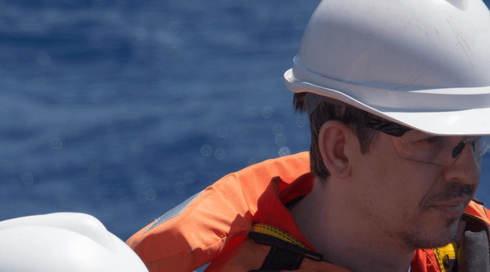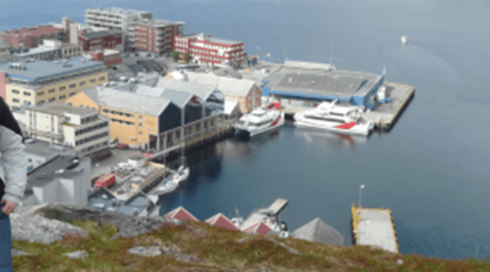2
Did you know that Atlas Professionals is a center of excellence for all things seismic? Especially our team in Vic? With this blog post, we will be going through the Seismic industry as well as our Vic, Spain office and how they are helming Atlas Professionals' Seismic efforts!
Well, led by Fiona Brown and Warren Reid the office is a team of 9 who service the Professionals who are involved in Seismic surveys and all that goes with that, such as the Environmental Professionals, MMOs (Marine Mammal Observers) and PAM (Passive Acoustic Monitoring) operators. The Vic Team (formerly Geomotive) became part of the Atlas Professionals family back in 2013. There’s been a lot of up and downs since then, but we are proud to say we keep being the market leader in the Seismic industry, with a pool of competent Professionals working for our clients in the different seismic surveys across the world.
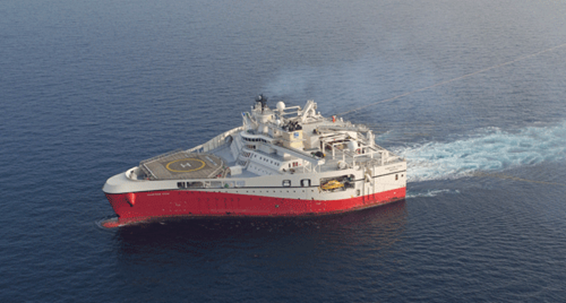
The Ramform Titan, seismic acquisition vessel
But what are seismic surveys?
These cutting-edge surveys have played a pivotal role in the discovery of oil and gas reserves, the development of renewable energy sources, and the enhancement of our knowledge of marine geology.
They are a specialized technique used to create detailed images of the Earth's subsurface layers beneath the seabed. The process involves the controlled emission of sound waves into the ocean, which travel through the seabed and underlying geological structures. When these sound waves encounter different rock types or formations, they reflect back to the surface, where they are recorded by sensitive hydrophones (waterproof microphones!).
The data collected during the survey is then processed and analyzed to create three-dimensional images, known as seismic profiles. It is these profiles that provide the information about the composition, structure, and therefore potential resources beneath the ocean floor.
Why are there seismic surveys?
- For Oil & Gas Exploration, offshore seismic surveys are instrumental in locating oil and gas reserves beneath the ocean floor. The data obtained from these surveys aids in identifying potential drilling locations, minimizing the risk of dry wells, and maximizing production efficiency.
- For Renewable Energy, the surveys also contribute to the development of renewable energy sources, such as offshore wind farms. By identifying suitable locations with favourable geological conditions, developers can make informed decisions about wind turbine placements, reducing environmental impacts and enhancing energy production. But also other technologies such as geothermal, depend on a clear understanding of geology.
- For Marine Geology, seismic surveys play a crucial role in advancing our understanding of marine geology and the Earth's tectonic processes. These surveys help geologists study geological phenomena, shedding light on the Earth's history and evolution.
- For Carbon Capture, transport and storage, seismic and electromagnetic surveys are increasingly being used to assess depleted oil and gas reservoirs, deep saline aquifers and coal beds for storage of CO2. Seismic surveys are also used for continuous monitoring of those storage sites to ensure there is no possible leakage.
How do you perform offshore seismic surveys?
Traditional seismic survey vessels are equipped with arrays of air guns (or other sources of big sounds!) that emit the sound waves. Additionally, they tow arrays of long cables containing the hydrophone sensors that detect the reflected signals (called Streamers).
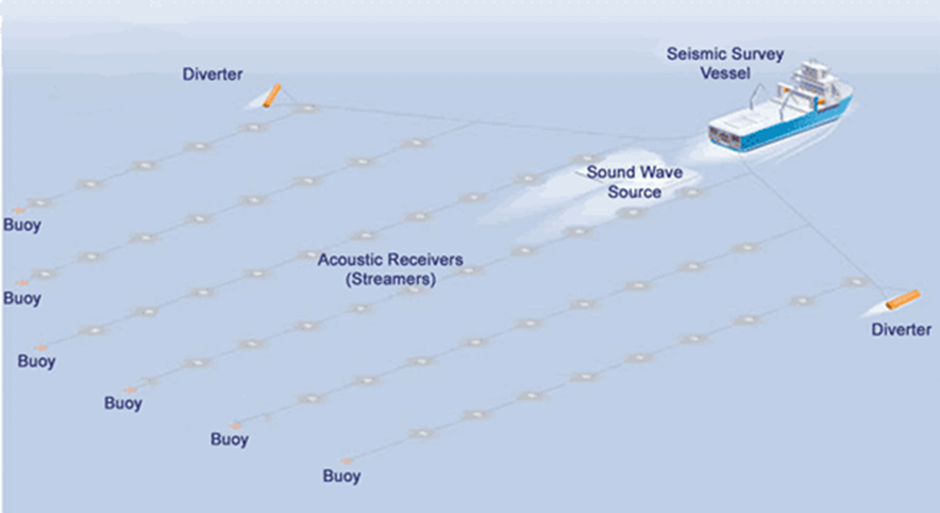
Vessel towing an array of hydrophones (streamers)
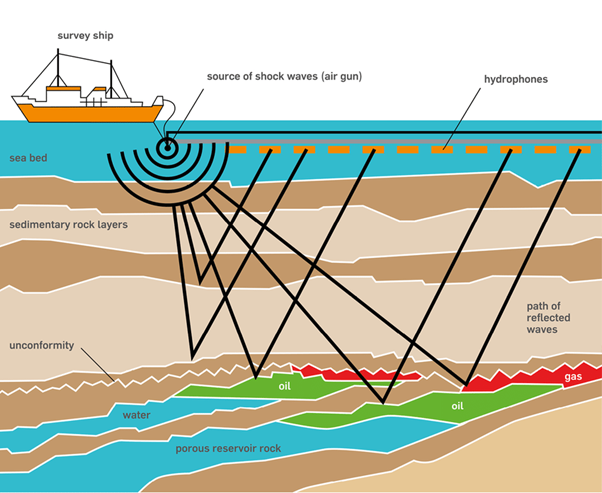
Diagram showing reflection of acoustic waves from different geological features
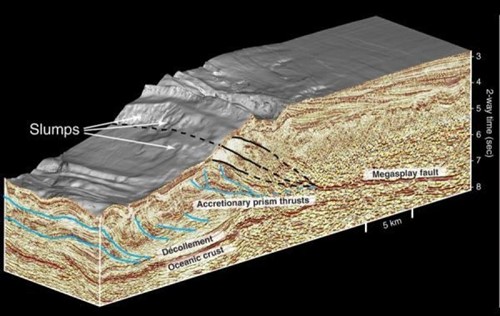
An example of processed seismic data
But there’s also a new(ish) method out there now! The use of Ocean Bottom Nodes (OBNs): Large autonomous nodes that can record data for over 60 days. They sit on the seabed, often deployed there by ROVs, and read the acoustic reflections from air guns on a source vessel. Being on the seabed their acquisition is of the highest quality and allows chronological comparisons. Being more efficient, they also drive down costs. OBN surveys are now more common than the traditional towed streamer surveys.

Diagram of Ocean Bottom Nodes
There is also an additional method of survey that the Vic office supplies professionals for: EM surveys (electromagnetic surveys). These use an electric dipole source (CSEM: Controlled source electromagnetic) and EM receivers: this is performed using approximately the same operating principle as the traditional seismic method but using electromagnetic waves instead of acoustic ones. These EM waves map the electrical conductivity of rocks and fluids beneath the seafloor instead of their ‘reflectivity’. This allows imaging of the geology which may have little seismic signature. These surveys are often a faster and lower cost method for investigating the geology and are regarded as having little or no effect on marine wildlife in the survey area.
What are the environmental considerations of seismic surveys?
While traditional offshore seismic surveys offer invaluable benefits, they are not without environmental concerns. The use of high-intensity sound waves can have an impact on marine life, particularly marine mammals and fish species. The loud noises may disrupt communication, migration patterns, and feeding behaviours, potentially leading to stress or even injury.
To mitigate these effects, industry practices and regulations have evolved to include measures like controlled sound levels, seasonal restrictions in sensitive areas, and real-time monitoring for the presence of marine life. Environmental impact assessments are an integral part of the survey planning process, ensuring responsible exploration, and minimizing adverse effects on marine ecosystems. This is where Atlas supply MMOs and PAMs…
What roles do we supply to the Seismic industry?
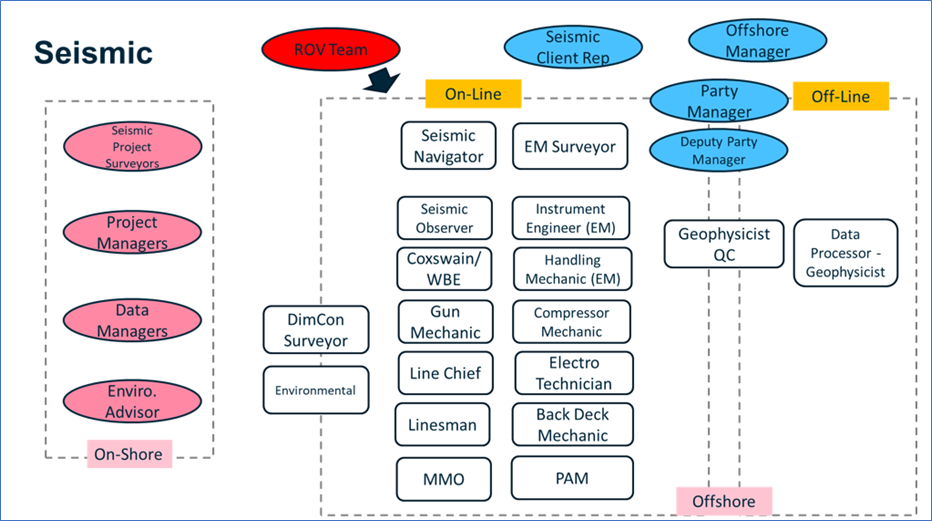
Here at Atlas Professionals, there is always something exciting going on when it comes to anything and everything related to the Seismic industry. If you are interested and looking forward to your next opportunity within this growing niche, check out our Seismic vacancies here!
Interested to find out more about our involvement in Seismic industry? Then please feel free to reach out to Paul Hampton in Business Development or Fiona Brown in Seismic!
.png)
.png)
